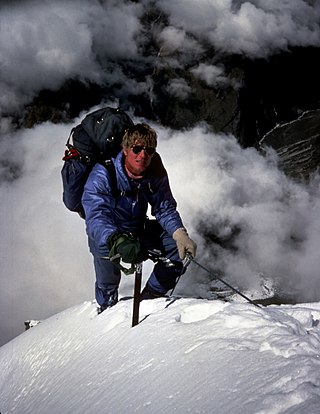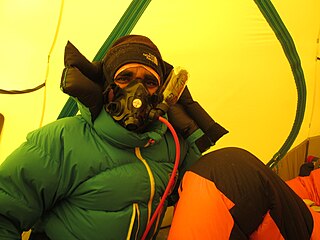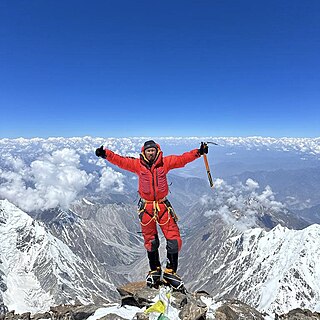
K2, at 8,611 metres (28,251 ft) above sea level, is the second-highest mountain on Earth, after Mount Everest at 8,849 metres (29,032 ft). It lies in the Karakoram range, partially in the Gilgit-Baltistan region of Pakistan-administered Kashmir and partially in the China-administered Trans-Karakoram Tract in the Taxkorgan Tajik Autonomous County of Xinjiang.

Annapurna is a mountain situated in the Annapurna mountain range of Gandaki Province, north-central Nepal. It is the 10th highest mountain in the world at 8,091 metres (26,545 ft) above sea level and is well known for the difficulty and danger involved in its ascent.

Lhotse is the fourth-highest mountain on Earth, after Mount Everest, K2, and Kangchenjunga. At an elevation of 8,516 metres (27,940 ft) above sea level, the main summit is on the border between Tibet Autonomous Region of China and the Khumbu region of Nepal.

Reinhold Andreas Messner is an Italian climber, explorer, and author from South Tyrol. He made the first solo ascent of Mount Everest and, along with Peter Habeler, the first ascent of Everest without supplemental oxygen. He was the first person to climb all 14 eight-thousanders, doing so without supplementary oxygen. Messner was the first to cross Antarctica and Greenland with neither snowmobiles nor dog sleds and also crossed the Gobi Desert alone. He is widely considered to be the greatest mountaineer of all time.

Cho Oyu is the sixth-highest mountain in the world at 8,188 metres (26,864 ft) above sea level. Cho Oyu means "Turquoise Goddess" in Tibetan. The mountain is the westernmost major peak of the Khumbu sub-section of the Mahalangur Himalaya 20 km west of Mount Everest. The mountain stands on the China Tibet–Nepal Koshi Pradesh border.

The eight-thousanders are the 14 mountains recognised by the International Mountaineering and Climbing Federation (UIAA) as being more than 8,000 metres (26,247 ft) in height above sea level, and sufficiently independent of neighbouring peaks. There is no precise definition of the criteria used to assess independence, and at times, the UIAA has considered whether the list should be expanded to 20 mountain peaks by including the major satellite peaks of eight-thousanders. All of the eight-thousanders are located in the Himalayan and Karakoram mountain ranges in Asia, and their summits lie in an altitude known as the death zone.

Broad Peak is one of the eight-thousanders, and is located in the Karakoram range spanning Gilgit-Baltistan, Pakistan and Xinjiang, China. It is the 12th highest mountain in the world with 8,051 metres (26,414 ft) elevation above sea level. The first ascent of this mountain was in June 1957, accomplished by Fritz Wintersteller, Marcus Schmuck, Kurt Diemberger, and Hermann Buhl as part of an Austrian expedition.

Shishapangma, or Shishasbangma or Xixiabangma, is the 14th-highest mountain in the world, at 8,027 metres (26,335 ft) above sea level. It is located entirely within Tibet. In 1964, it became the final eight-thousander to be climbed.

Scott Eugene Fischer was an American mountaineer and mountain guide. He was renowned for ascending the world's highest mountains without supplemental oxygen. Fischer and Wally Berg were the first Americans to summit Lhotse, the world's fourth highest peak. Fischer, Charley Mace, and Ed Viesturs summitted K2 without supplemental oxygen. Fischer first climbed Mount Everest in 1994 and later died during the 1996 blizzard on Everest while descending from the peak.

Edmund Viesturs is an American high-altitude mountaineer, corporate speaker, and well known author in the mountain climbing community. He was the first American to climb all 14 of the eight-thousander mountains, and the 5th person to do so without supplemental oxygen. Along with Apa Sherpa, he has summitted eight-thousanders on 21 occasions, including Mount Everest seven times.

Edurne Pasaban Lizarribar is a Basque Spanish mountaineer. On May 17, 2010, she became the first woman to climb all 14 of the eight-thousanders – and the 21st person to do so. Her first 8,000 peak had been achieved 9 years earlier, on May 23, 2001, when she reached the summit of Mount Everest. She has also completed the seven summits.
Andrew James Lock OAM is an Australian mountaineer. He became the first, and still remains the only, Australian to climb all 14 "eight-thousanders" on 2 October 2009, and is the 18th person to ever complete this feat. He climbed 13 of the 14 without bottled oxygen, only using it on Mount Everest, which he has summited three times. He retired from eight-thousander climbing in 2012.

Expedition climbing, is a type of mountaineering that uses a series of well-stocked camps on the mountain that lead to the summit, and which are supplied by teams of mountain porters. In addition, expedition climbing can also employ multiple 'climbing teams' to work on the climbing route—not all of whom are expected to make the summit—and allows the use of supports such as fixed ropes, aluminum ladders, supplementary oxygen, and sherpa climbers. By its nature, expedition climbing often requires weeks to complete a given climbing route, and months of pre-planning given the greater scale of people and equipment that need to be coordinated for the climb.

Alberto Iñurrategi Iriarte is a Basque Spanish mountaineer born in Aretxabaleta, Gipuzkoa, Basque Country. In the year 2002, he became the second Basque and Spaniard and the 10th person to climb the 14 eight-thousanders.

Chhang Dawa Sherpa : is a Nepalese mountaineer and the youngest climber till 2019 to summit the 14 highest peaks. Dawa and his brother Mingma Sherpa together hold the world record as "first brothers to summit the 14 highest peaks", a single record shared by the two.

Nirmal Purja is a Nepal-born naturalised British mountaineer. Prior to taking on a career in mountaineering, he served in the British Army with the Brigade of Gurkhas followed by the Special Boat Service (SBS), the special forces unit of the Royal Navy. Purja is notable for having climbed all 14 eight-thousanders in a time of six months and six days with the aid of bottled oxygen. This was a record at the time of climbing, although it was broken in 2023 by Kristin Harila and Tenjen Sherpa, who summitted all 14 eight-thousanders in 92 days. Purja was the first person to reach the summits of Mount Everest, Lhotse and Makalu within 48 hours. In 2021, Purja, along with a team of nine other Nepalese climbers, completed the first winter ascent of K2.

Mingma Gyabu Sherpa, is a Nepalese mountaineer and rescue climber. He is the youngest person to climb all 14 eight-thousanders, and holds the Guinness World Record for "Fastest time to climb Everest and K2", which he did within 61 days.

Mingma Dorchi Sherpa is a Nepali sherpa mountaineer and a professional trekking guide from Sankhuwasabha District, Nepal. He holds the Guinness World Record for being the fastest person to step on the summit of both Mount Everest and Lhotse in a record time of 6 hours and 1 minute.

Kristin Harila is a Norwegian mountaineer and former cross-country skier. During 2022–2023, she set multiple speed records for the ascent of all 14 eight-thousanders, which are the peaks in the world that are over 8,000 metres in elevation.

Tenjen Sherpa, also known as Tenjen Lama Sherpa, was a Nepalese mountaineer, who climbed all 14 eight-thousanders together with Kristin Harila in 92 days. He went missing after an avalanche hit on Shishapangma on 7 October 2023. He was declared dead by Chinese authorities on 8 October 2023.



















